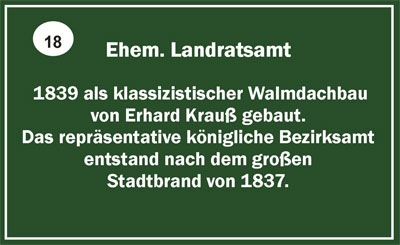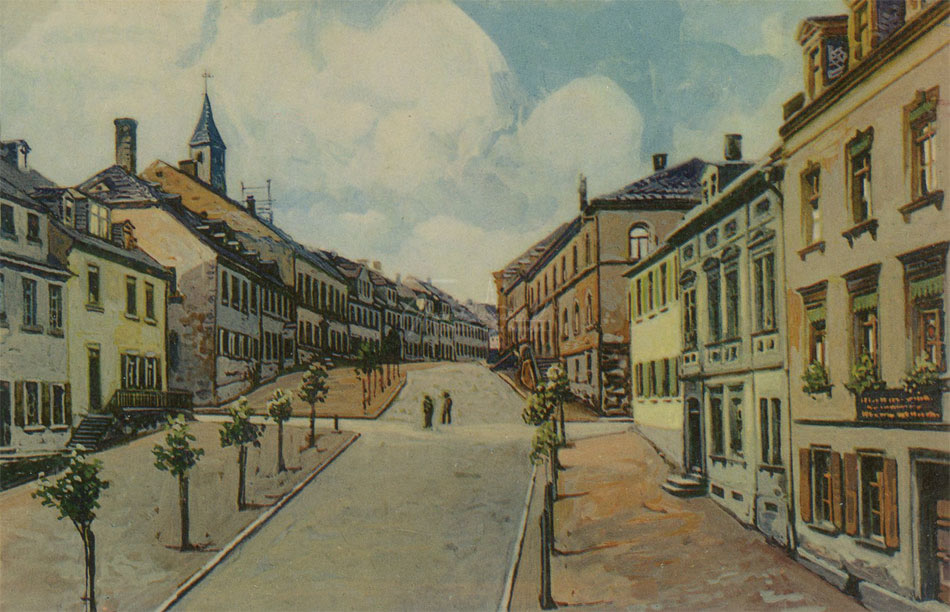
Building Number 18 in the printed brochure
"Historic Buildings in Münchberg".
The sign is next to the arcade passageway.
Even when the city of Münchberg belonged the Principality of Bayreuth, there was a margrave’s treasury office, which was converted to the chamber offices of Münchberg in Prussian times (1792-1806) by the Hardenberg Organization (June 1, 1797). The chamber offices, as well as predecessors of the council, were housed in 13 Ludwigstraße.
After the surrender of the Principality of Bayreuth to the Kingdom of Bavaria on June 30, 1810, by virtue of the later decree of August 16, 1811, the Prussian Chamber Office of Münchberg became a Bavarian outpost. Effective March 1, 1812, the administration of justice and general administration had been entrusted to the Bavarian courts. This new authority of Münchberg had to be appropriately accommodated. The three-storey house of master butcher Hannemann’s widow was especially suitable. On January 29, 1813 the Bavarian government granted the purchase and rebuilding of the regional courts building at the current site at the corner of Ludwigstraße and Amtsgasse. In 1826/27 the main street to the court was shifted from Ludwigstraße to Bismarckstraße so that it no longer went through the middle of the city. As a result of this well directed shift the city could still have an adjoining property that would be used for the enlargement of the court gardens.
With the great fire of August 12, 1837 almost all of the houses in the upper city were destroyed, including the regional courts building. With the plans to rebuild, the government had in mind to place the district next to the existing revenue office, which had been located on Hofer Straße since 1824. The magistrate and the community were authorized with that, but were not in agreement. Innkeepers, shopkeepers and craftsmen feared that the rural population would no longer come to the city aside from visits to the convenient offices, and so damage to their business was feared. In 1838 it was decided by the Ministry of the Interior in Munich to erect the building of the revenue offices and the district court once again in their original sites. There were, however, discussions due to the danger of fire and that it would probably be better to build only two storeys high, rather than the previous three storeys. On the lower level service businesses would be carried out, and the upper storey would serve as apartments for the judicial trustees. Since the new two-storey house had to have double the space, the ground floor of the adjoining pharmacy, which had likewise been burned down, was acquired. In a counter move the city bought the scene of the fire of the bricklayer Erhard Krauß and the country doctor Wolf, so that the pharmacist Barth could build his city pharmacy at the new location at 28 Ludwigstraße. There were further difficulties when the government also still resisted the purchase of the ground floor, situated on the upper part, since the new building should now have the front facing the Hauptstraße. Therefore, the owner of the building, master tailor Kraus, had to leave the old Fronfeste behind the town hall, and be paid a compensation of 300 Gulden, since he had already begun reconstruction. Since now all problems were eliminated, the Ministry of the Interior gave the approval as well on January 29, 1839 for the reconstruction of the district court and approved 22,500 Gulden for it. At the same time 9,300 Gulden was provided for the prison to be built behind it. Since the business and living spaces of the district court were relocated to the houses of master baker Schwenk and the cellarman Kaufmann on Kulmbacher Straße after the great fire there was a lack of space and accordingly operation of services was not possible. Besides, there was a great danger of fire with the shingle covered wooden houses. So they pushed for a quick rebuilding of the district court and left out the laying of the corner stone in the process of the hurried construction. Instead, a dignified ceremony was held for the roof framing on September 28, 1839. The invited royal officials, civil servants and honorees gathered at 9 a.m. Along with the official part they celebrated the entire day with music and dancing into the night at Gasthof zur Post, (Bayerischer Hof) and at Harmonielokal.

The exterior view of the building has hardly changed since then, merely the businesses and the names, which they chose. On July 1, 1862 it was converted to the district exchange of Münchberg, and the working area was restricted to the administration. The administration of justice was transferred to the regional courts’ new system, the later district court. In 1939 the administrative authority was given the name “district councilor”, while a regulation in 1946 introduced the designation “Office of the District Administrator” In 1962 arcades were built on the ground floor on the Amtsgasse. On July 1, 1972 the district of Münchberg was resolved as a result of the territorial reforms in Bavaria. In 1978 the district Hof received its present form, to which the largest part of the Münchberg old district now belongs. The remaining part is now incorporated into the district of Bayreuth. Currently the vocational training school for nursing of the HochFranken clinics is housed in the building.
Before the great fire of 1837 the city pharmacy, in which Johann Wolfgang Döbereiner worked, stood in the area of the left side of the building. In the house that stood on the site of the present day right half of the building Cornelia Vetterlein, the daughter of chamber law clerk Johann Karl Martin Vetterlein was born in 1811.
Video: Aerial view – Office of the District Administrator
Copywriters, authors, photographers, rights holders or sources:
Rainer Fritsch, Sandy Schroeder, Karl Dietel, city archives
Audio File

